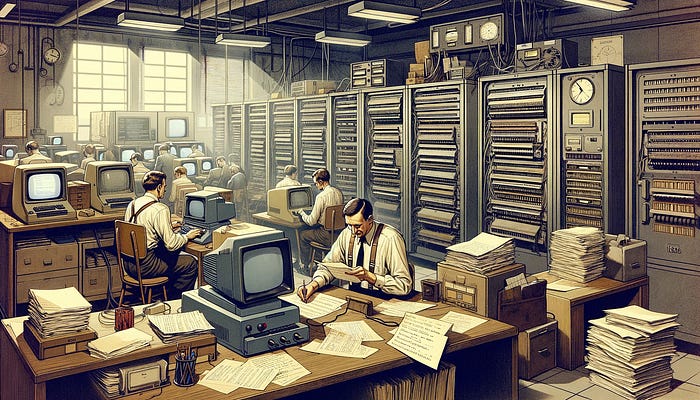From Manual to Automated: From Tedious Manuals to Intelligent Automation
Tracing the evolution from primitive origins to an exponentially advancing future
Software testing has undergone a remarkable transformation since the early days of computing. What began as a tedious, manual process has evolved into a complex discipline at the cutting edge of technology. This evolutionary journey reflects the growing sophistication of the software development landscape.
The Primitive Beginnings
To understand testing automation, we must first travel back to a time when the software industry was in its infancy. In the 1950s, software was secondary to hardware. Programs were rudimentary, written to demonstrate capabilities of the limited computers of that era. Software testing as we now know it did not exist. It was the sole responsibility of a programmer to test the code he had written.
Manually testing even simple programs required monumental effort. Testers painstakingly examined code line-by-line, comparing behavior against requirements. What we now refer to as unit testing was blended with system testing at this primitive stage. Considering the technological limitations of early computers, exhaustive testing demanded long hours for marginal gains in defect detection. The absence of clear processes caused critical defects to slip through the cracks. Software testing was ad-hoc, unstructured, and dependent solely on the diligence of the programmer rather than any standardized methodology.
While manual methods sufficed in an era of limited complexity, the stage was being set for the revolution to follow. The advent of programming best practices created a need for more thorough testing.
The First Steps Towards Rigor
The 1970s witnessed the rise of structured programming paradigms. Code complexity was increasing exponentially as more functional capabilities got incorporated into software. This period saw the introduction of techniques that would lay the foundation for modern software testing:
Unit Testing — Testing individual modules in isolation emerged as an essential practice to verify correct functionality of the smallest testable portions of code. Although performed manually, unit testing marked the early phases of a shift towards rigor and structure in software testing.
Integration Testing — Assembling software components and testing interconnected modules was recognized as a necessary validation step between unit testing and complete system testing.
Functional Testing — Validating software behavior against written specifications became a cornerstone technique. Black box testing of inputs and outputs helped formalize testing processes.
This era marked software testing’s gradual shift from an informal quality check practice to essential rigor in validation. However, testing was still not perceived as a separate discipline and the processes relied exclusively on human effort — an approach that could no longer keep pace with evolving technology in the decade that followed.
Revolutionizing Efficiency — The Rise of Test Automation
By the 1980s, software size and complexity had grown substantially. As development accelerated, the time intensity and effort duplication in manual testing reached unsustainable levels. Coding errors that slipped past human testers led to catastrophic software failures, most notably the Therac-25 radiation therapy machine accidents that resulted in patient deaths. Software quality assurance could no longer rely solely on human effort, oversight, and ad-hoc processes.
In response to the increasing complexities and need for efficiency, the late 1980s and early 1990s saw pioneering advancements in test automation with the introduction of commercial automated testing tools:
Data-Driven Testing — Test data was separated from test procedures allowing for repeated test execution without scripts requiring modification for each scenario.
GUI Testing Tools — Automation tools could now programmatically interact with and test Graphical User Interfaces. This expanded test automation beyond pure backend system testing.
Scripting Capabilities — Testers could code complex user workflows and system interactions through scripting instead of manual step execution. These test scripts could execute without human intervention, allowing for unattended test runs.
Software-based Regression Testing — Automation enabled reliable regression testing by executing defined test scripts repeatedly as code changes were introduced. This provided confidence in the absence of unintended side effects when adding enhancements or modifying software code.
These innovations transformed software testing with pronounced improvements in efficiency, consistency, reliability and test coverage. However, since automation tools still functioned in isolation at this stage, software quality assurance as a holistic discipline remained fragmented. A true revolution in software testing required the evolution of software development methodologies to catch up to advances in standalone automation.
Welcome to the Age of CI/CD
While test automation addressed the symptom of slow and inconsistent manual testing, accelerated software delivery was held back by traditional waterfall development processes. The early 2000s saw this change significantly with the advent of Agile methodologies that enabled continuous iterations and frequent releases. This aligned with the increasingly rapid technology lifecycles.
Automation now extended beyond localized test execution to an end-to-end framework, with integrated tools for continuous builds, testing, integration and deployment. This ushered in the DevOps culture that demolished barriers between software development and operations — an essential catalyst to the Continuous Integration/Continuous Delivery model that dominates modern software engineering.
Shifting Left on Quality — Software testing was no longer siloed, but embedded across the development lifecycle — from requirement reviews to code reviews, unit testing, integration testing and operational testing in production environments. Issues could now be prevented early before making down the process.
Test Automation for Rapid Feedback Cycles — Automated unit testing and builds enabled constant validation of code integrity. Integration of system-level test automation provided a safety net for rapid releases to meet market demands.
Infrastructure as Code — Configuring test environments and infrastructure through code rather than manual setup enabled dynamic orchestration of testing pipelines.
No More Periodic Testing — Near constant integration eliminated the very need for periodic system testing. Developers received ongoing feedback on the impact of code changes rather than waiting for scheduled testing cycles.
By fully adopting a culture of DevOps, Continuous Integration, Continuous Delivery and infrastructure automation, software testing was no longer the impediment to accelerated delivery, but rather the catalyst enabling it.
This new development paradigm allowed cloud-based software organizations to disrupt entire industries at unprecedented speeds. The 2010s witnessed a Cambrian explosion that produced revolutionary software-driven business models which displaced conventional incumbents across sectors. None of this hyper-speed innovation would have been possible without equally rapid test cycles.
The Exponential Future — AI and ML join CI/CD
While CI/CD and test automation boosted productivity within human capabilities, modern software processes are increasingly stretching teams to their limits. Thankfully, as with prior plateaus, computer science has stepped in with the next evolutionary technology to breach constraints.
API Testing — GUI test automation sufficed for monolithic applications but distributed microservices architectures demanded specialized API testing tools. Next generation frameworks now provide holistic API testing capabilities.
AI Test Case Generation — Leveraging neural networks to automatically generate high-risk test scenarios that human testers would likely overlook.
Smart Test Coverage Analytics — ML collecting code complexity metrics to ensure adequate test coverage across all probable pathways. DNA testing of code!
Self-Healing through Autonomous Monitoring — No more waiting for human-written scripts. AI systems autonomously monitor systems and initiate corrective actions without engineer intervention.
The list expands exponentially, as it has with each evolutionary step in software testing. Yet patterns emerge — each innovation aims to either eliminate or augment human effort and judgment using an exponentially smarter automation capability.
The Journey Continues
In six decades, software testing has evolved from informal human diligence to increasingly specialized automation, now being superseded by artificially intelligent systems. This journey mirrors the evolution of software engineering as a whole — with automation tackling progressively advancing challenges.
It begs the question — could AI rendered software testing, and potentially software development altogether, beyond the need for human input? Perhaps. But forecasts beyond technological possibility frequently miss the mark. In practice, paradigm-altering innovations uncover new realms rather than cementing an end state. Mainframes were predicted to be the future; they remain integral yet the proliferation of personal computing accelerated advancement far beyond expectations. Test automation was projected to replace manual testing; human insight remains crucial as criteria continuously expands.
Therefore, while breakthroughs in intelligent test automation will profoundly impact software quality assurance, testing will likely continue to evolve in lockstep with software capabilities, rather than culminate in culmination. Because the only constant is change itself. The future remains unwritten.










